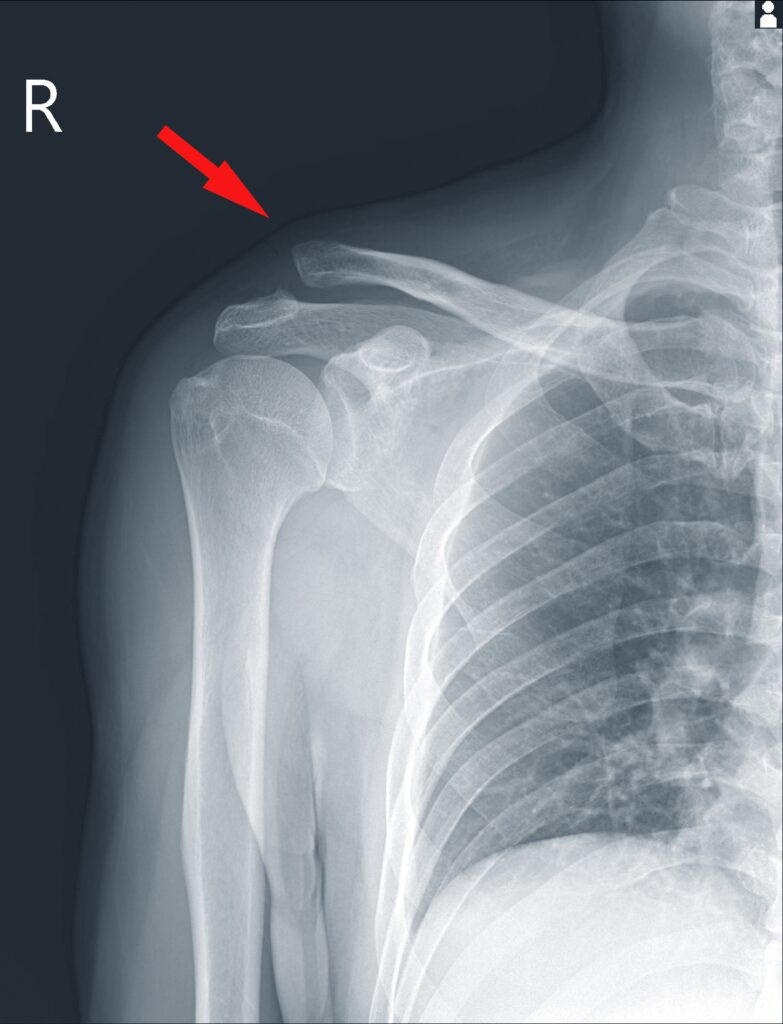Acromioclavicular (AC) Separations
A grade 3 AC joint sprain or a separated shoulder is a tearing of the ligaments/joint capsule connecting the shoulder blade (scapula) to the collar bone (clavicle). This usually occurs with trauma to the top of the shoulder such as when somebody falls directly on their shoulder. When this happens the collar bone rides up higher than the shoulder blade causing a bump on the shoulder. When looking at a patient with such an injury it may appear that the collar bone is raised up. In reality the collar bone is usually in the correct position but the shoulder blade and the rest of the shoulder is actually lower than it usually is.
A grade 3 differs from a grade 1 or 2 in that both major connections of the clavicle to the scapula (collar bone to the shoulder blade) have been disrupted. The treatment for a grade 3 AC joint sprain is somewhat controversial and is always decided by the patient.
If non-operative treatment is chosen then the patient will usually heal the sprain over the ensuing 6 weeks. Unfortunately there is no non-operative treatments which can reliably hold the collar bone and the shoulder blade in their normal relationship. As such, when the 6 weeks is over and the ligaments have healed, they will have healed in an elongated manner. This results in continued deformity of the shoulder (the collar bone appears high or the shoulder appears low and there is a large bump over the shoulder). In spite of this most patients can return to normal activities after the 6 week period. Some patients will complain of weakness and or pain in the shoulder. Some will have cosmetic complaints. Some will have complaints of ill-fitting cloths or backpacks.
Because of the worry of these potential problems with enduring deformity of the AC joint which occurs after non-operative treatment, many patients will choose to undergo surgery in an attempt to restore the normal relationship between the collar bone and the clavicle. In this short surgery under general anesthesia (the patient is asleep), the collar bone and the scapula are re-approximated and held together with either a screw or stitches. The patient is given a sling and asked not to use the arm for anything heavy for 6 weeks (writing, typing, mouse work, eating, washing face, etc…are O.K.). After 6 week if the patient has a screw then it is removed under general anesthesia. After 6 weeks the patient then must rehabilitate the shoulder with stretching and strengthening under the guidance of a therapist. Usually the patient returns to normal activity by 3 months or so. Usually, but not always, the relationship between the collar bone and shoulder blade is normal or near-normal. This surgery should be done within the first 10 days of the injury.
If the acute repair of the AC joint does not succeed in restoring the normal relationship of the collar bone to the shoulder blade or the patient initially chose to undergo non-operative treatment of the grade 3 AC joint sprain and is unhappy with @HIS@ results, then the patient may choose to undergo a surgical reconstruction of this joint. During this procedure the patient is asleep and the end of the clavicle is removed and the major ligament are reconstructed using donated tendon from a cadaver (allograft). It must be noted that while this procedure can succeed in restoring the normal or near-normal relationship of the collar bone to the clavicle, it has a lower success rate than an initial repair.
